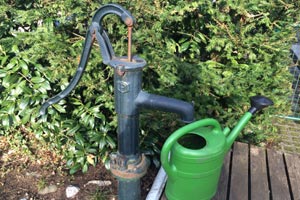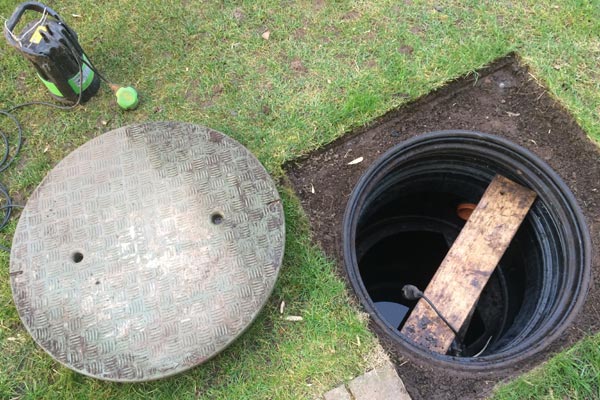An issue for every amateur gardener: having rainwater on hand for watering at all times during summer drought and heat. It is worth converting the irrigation of your garden to this – whether water tank, rain barrel or cistern. Use soft, low-lime rainwater for your plants and save drinking water. We tell you how it works.
In addition to the positive effect of saving real money on your annual water bill – especially with the increasingly dry summers – your plants prefer the low-calcium, soft rainwater. For hydrangeas or rhododendrons, for example, this is a great advantage. In addition, you water with warmer water, because it does not come directly cold from the tap and is distributed to the plants – your garden is also happy about this.
Contents
Collect rainwater from the roof
The fastest and cheapest solution: set up rainwater barrels or drums. Typically, the barrel is placed at the downspout, which drains water from the roof surface. A rainwater flap above the edge of the barrel directs the water into the barrel. A watering can can then be used to conveniently scoop the water from the rain barrel and use it to water the garden.
A simple plastic rain barrel with a lid and a drainage tap at the bottom is available in hardware stores from about 20 to 30 euros. The barrels are available in all sizes, about 200 liters is an average capacity, they can also put 300- or 400-liter barrels if there is enough space. The shapes tend to become more basin-like as the size increases. Make sure that the barrels are frost-resistant and do not crack and leak in severe winters, otherwise scoop them in time.
Water tank in the desired design.
Likewise, decorative variants are available here, for example, if you are planning the watering hole near the terrace: they are available in column form, as a large vase or amphora in terra cotta.
Larger rainwater tanks can be clad with wood or stones on a house wall, for example, and thus integrated into the overall design of the property.
Attach a water tap to the barrel

It makes sense to attach a spigot to the bottom of the basin or tank when it reaches a certain size, so that you don’t have to scoop water but can tap it into a watering can. Most tanks and basins have a thread at this point so that any tap can be screwed on.
A lid or cap on the open side should be included in the planned set to prevent the water basin from becoming a breeding ground for mosquitoes. In addition, this will prevent algae growth.
Insert downpipe filter
Important for the drainage of water from the gutter: a so-called downpipe filter. It is mounted on the downspout, filters leaves and dirt out of the water stream and drains the water into the barrel or tank. Here there are simple models with leaf filter starting at about 20 euros. High-quality copies are more expensive, but worth considering because of the long-term use.
Installing a cistern in the garden
The convenient, large variant for a water tank is an underground tank for rainwater – that is, a water tank installed underground. The one-time expense looks like this: You have a hole dug in the garden, the tank is delivered and embedded, connected to the water inlet and outlet, and then refilled with soil. Above the tank or cistern, you lay or sow a new garden area.
The first major advantage is that you have a supply of rainwater available all year round. This type of water tank comes in various sizes. However, because of the larger preliminary work – excavation, embedding, new soil design – the expense is only worthwhile for 1,000 to 2,000 liters or more. If you have enough garden space, however, larger tanks or cisterns are also well conceivable.
The second advantage is that the tank is invisible underground and does not take up valuable space in your garden or around the house.
Advantage number three: water extraction is convenient and time-saving. The most convenient way is to connect an electric pump to pump the water up from the tank into your garden hose, garden sprinkler and for withdrawal at the above-ground faucet. Electric pumps are available in hardware stores starting at about 30 to 50 euros. This is particularly recommended for larger green and lawn areas – here watering by hand can quickly become a sweaty effort.
We have installed an inexpensive electric clear water submersible pump in the cistern and it runs reliably to this day.
Another idea: You can use timers to couple your lawn sprinkler with this rainwater connection and set it to the ideal watering time in summer – the early morning hours. For larger beds, sprinkler systems can also be connected. Watering the lawn properly – this is how it’s done.
If a power connection with an electric pump is too expensive, you can use a hand water pump, for example a swing pump. This is screwed onto the opening of the tank and the water is extracted by manually moving the swivel.
Inlet, outlet and overflow of the underground tank.

The underground tank or cistern basically provides three connections: First, the inlet for feeding rainwater into the tank. Here you lay a pipe from the gutter or downspout or other source of rainwater to the tank.
Second is the connection to draw off the water. Whether via a well pump or electrically operated – the garden irrigation can then be conveniently expanded: Via a pipe, for example PE pipes, available in hardware stores, the electric pump carries rainwater out of the tank to the desired location for a separate rainwater connection. To do this, you simply lay a piece of pipe underground in the garden to the destination – away from the tank. If you are using an electric submersible pump in the tank, you will also need to provide a conduit from the tank to the power connection.
Third, provide an overflow for the tank. When the tank is full to the brim, the excess water supplied must be drained. Most models have openings for this, or it can be easily set up.
When do I open the water tank?
The tank opening includes a lid, which can usually be used to close the tank via a thread. This lid can later be additionally covered by a wooden frame or similar. With good planning, the lid or cover reaches exactly the level of the surrounding surface – so that the tank access is almost invisible at ground level. When lowering in the cistern, make sure that the lid of the tank sits as level as possible. Later, this can not be corrected.
Access to the water tank is necessary, for example, before the first frost days to remove the electric pump, clean it and store it dry over winter. After a few years of operation, it is impossible to avoid the accumulation of mud and silt at the bottom of the tank. That’s when you should schedule a cleaning.
No matter which water tank you choose: Rainwater provides ideal conditions for your garden plants – you have the security of watering with soft water without additives or impurities, save valuable drinking water and also more money every year.


